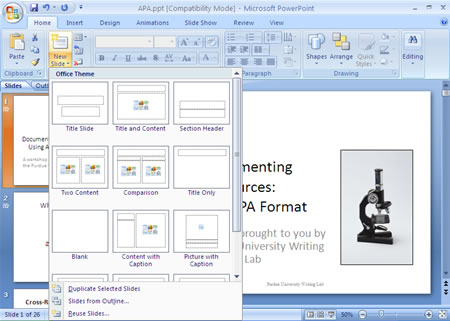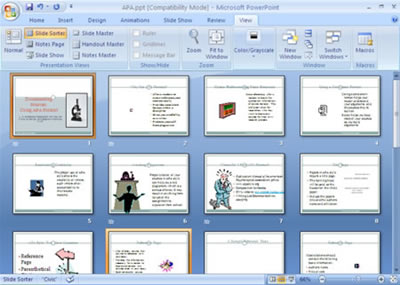A Tour of PowerPoint
To help you understand what you are getting into, the rest of this tutorial provides a tour of PowerPoint. It explains what creating a presentation entails, from inserting the first slide to putting on the finishing touches. Better fasten your safety belt.
Creating the slides
After you create a new presentation, your next task is to insert the slides. As shown in figure, PowerPoint offers many preformatted slide layouts. These layouts are available on the New Slide dropdown list, the drop-down list you open when you want to insert a slide. Each layout is designed for presenting information a certain way.

As you create slides, you can jot down notes in the Notes pane. You can use the notes later on to formulate your presentation and decide what you will say to your audience while each slide is on-screen.
To help complete tasks, you can change views. Figure shows the Power- Point window in Slide Sorter view. This view is best for moving, copying, and deleting slides. PowerPoint offers the View tab and View buttons for changing your view of a presentation. The program offers many different views, each designed to help with a different task.

Designing your presentation
The next step is to think about the appearance of your presentation. Figure shows the Design tab, where you make most of the decisions that pertain to the presentation's look.

Starting here, you can change the slides colors and backgrounds. You can also choose a new "theme" for your presentation - an all-encompassing design that applies to all (or most of) the slides. If you are the type of person who does not run with the herd, you can overhaul one of these themes and in effect redesign it by switching to Slide Master view and tinkering with the master slides.
Choose a design for your presentation early on. The fonts, graphics, shapes, tables, and charts you put in your presentation have to fit the design. If you change designs after you have created the majority of your slides, you may have to choose new font colors and graphics. You may have to redesign your tables, charts, and diagrams as well because they don't fit into the new design you chose.
Inserting tables, charts, diagrams, and shapes
A PowerPoint presentation should be more than a loose collection of bulleted lists. Starting on the Insert tab, you can place tables, charts, and diagrams on slides. You can also adorn your slides with text boxes, WordArt images, and shapes. And when you include a bulleted or numbered list, you can employ nonstandard bullets and numbering schemes to make your lists a little different from everybody else's.
Use your imagination. Try to take advantage of all the features that PowerPoint provides for communicating with an audience.
Animating your slides
As we mentioned earlier, PowerPoint slides can play video and sound. You can also enliven a presentation by "animating" it. Starting on the Animations tab, you can make slide items bulleted lists, shapes, and clip art - arrive and leave the screen from different directions. You can make the items on a slide move on the screen. As a slide arrives, you can make it spin or flash.
Showing your presentation
During a presentation, you can draw on the slides. You can also blank the screen, show slides out of order, and detour your presentation into a customized slide show. Most presentations are made to be delivered in person by a speaker, but you can deliver presentations from afar by choosing commands on the Slide Show tab.
These kinds of presentations can run in your absence:
Self-running presentation:
A presentation that runs on its own and can be exhibited at a trade show or other public place.
User-run presentation:
A presentation that others can run. Special buttons permit individuals to go from slide to slide.
A handout:
A printed copy of a presentation.
A CD:
A packaged CD copy of a presentation that others can show on their computers (and you can take on the road). People who don't have PowerPoint can view presentations after they are packed for a CD.
A Web page:
A version of a presentation formatted for display on the Internet or an intranet.
